ASUS U30Jc: Refining Thin and Light Performance
by Jarred Walton on May 18, 2010 11:23 PM ESTASUS U30Jc LCD Analysis
I've often said that I prefer matte LCDs on laptops. Most of that comes from my experience using laptops outside, or at least near windows where I get some horrible reflections on the glossy displays. Like most consumer laptops, the U30Jc goes the glossy route, and like most inexpensive laptops it also uses a low contrast LCD panel. We don't like all the corner cutting that happens on LCDs, but unfortunately most manufacturers don't see LCD quality as something they can easily use to differentiate their system from the competition. And if you're trying to get shelf space at Best Buy, you're pretty much given a price target that you have to hit or you don't get in the door. $900 to $1000 is a pretty hard price cap for them, and so it's little surprise that LCD quality is once again sacrificed in pursuit of keeping costs down.
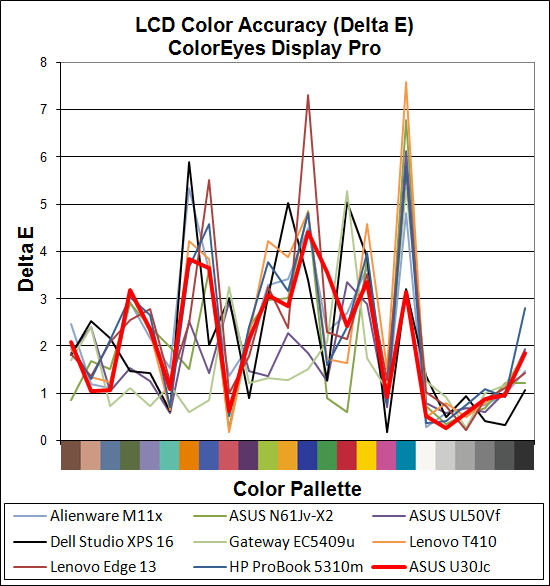

The test results above confirm our suspicions that this is yet another lousy laptop display (YALLD?). Contrast ratio is in the middle of the pack, but at 211:1 all of these displays are very poor. The 200nits white level is fine, and color accuracy is actually slightly better than most laptops (notice that the spikes on the U30Jc are only 3.5 to 4.5 instead of the 6.0 to 8.0 spikes on many other laptops). However, decent color accuracy isn't something most users will notice (or need) whereas a good contrast ratio can make a good impression.
Viewing angles are par for the course. It surprises me when I see other reviews talking about the display being "above average" or having good black levels. To be clear, a black level of nearly 1.0nits qualifies as pretty severe backlight bleed and is in no way "black". For a display running at 200nits, we would like black levels closer to .30nits. ASUS has done this (and more) with the 1005HA, 1001P, and the G73Jh; now we just need better quality displays in their nicer "budget midrange" offerings.


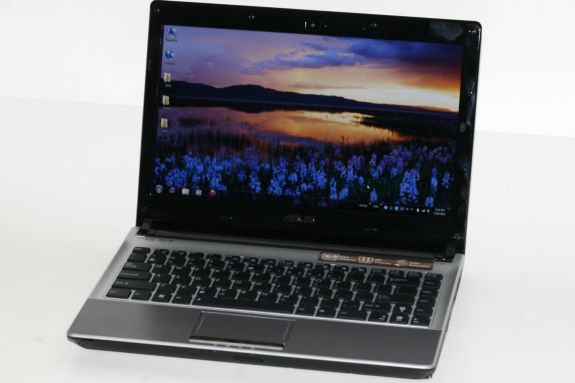
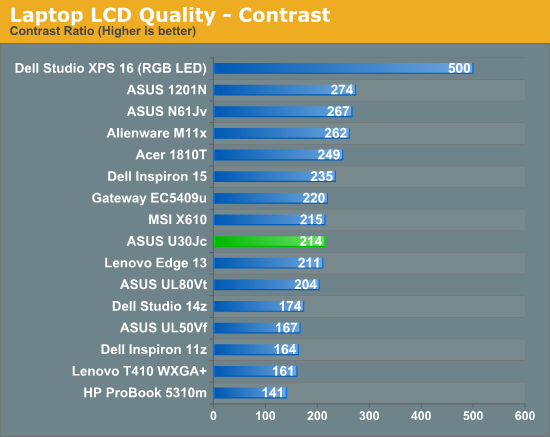
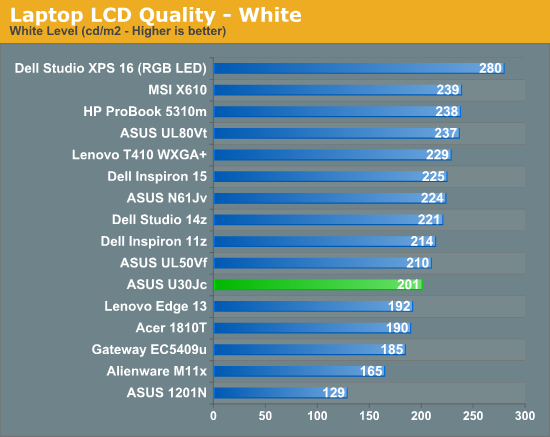

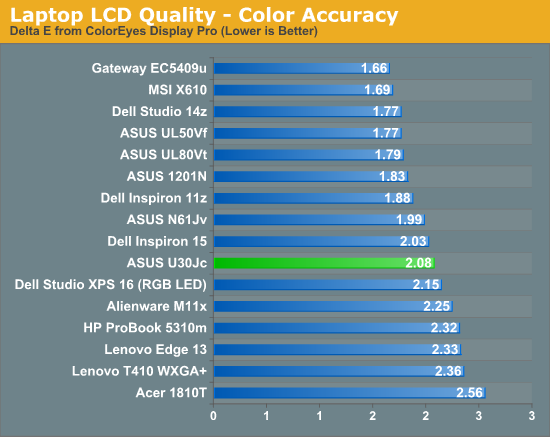
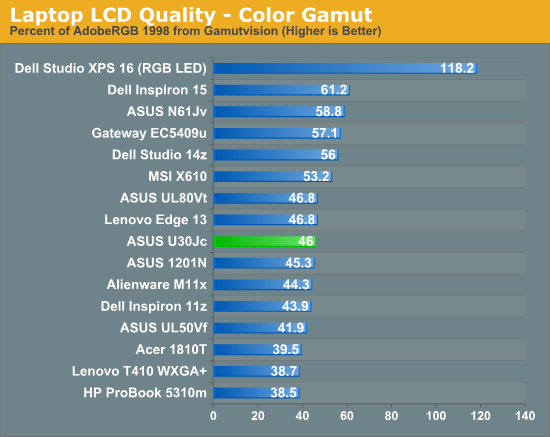














57 Comments
View All Comments
solipsism - Wednesday, May 19, 2010 - link
I'd like to see this machine compared with latest MacBook. There seems to be some evidence to suggest Apple did the right thing withs sticking with C2D this time around in their 13" machines. This machine seems to be a great machine which to compare.Daeros - Wednesday, May 19, 2010 - link
I agree completely. For the extra hundred bucks, you get similar specs, even better battery life (and Bluetooth), as well as somewhat faster graphics. For all the bashing Apple takes for its pricing, it seems that whenever a pc company like ASUS or HP or Dell attempt to get to that level of size & performance, it winds up being very close in price.I second a request for this to go head-to head with the 13" Macbook.
anandtechrocks - Wednesday, May 19, 2010 - link
I disagree completely. if you go by apple's claims you get less than 50 minutes more battery life, a processor that is anywhere from 15-40% slower, half the ram, a smaller hard drive, and a plastic case for $100 dollars more. I know what I'd pick...FATCamaro - Wednesday, May 19, 2010 - link
Please note that the Asus doesn't appear to come with abgn networking instead just bgn. So it only has a 2.4Ghz radio it seems, not a 5 Ghz. one. I could be wrong. Other than that and the shit LCD it is a fine MBP alternative for Windows users.anandtechrocks - Wednesday, May 19, 2010 - link
mbp is like $300 more than this isn't it? I think the regular MB is a better competitor, which also doesn't have the best LCD. don't forget apple offers half the warranty of this Asus tooJarredWalton - Wednesday, May 19, 2010 - link
Depending on the application, you'd need about a Core 2 P9700 (2.8GHz) to equal a 2.26GHz Core i3-350M. In highly threaded workloads, the only way you'd com anywhere near the faster Core i5 processors is by getting a Core 2 Quad, but with the lower clock speeds on quad-core you'll be slower in lightly threaded tasks (i.e. the i3-350M is as fast as Q9000 in PCMark Vantage). It all depends on the app, but when you consider Core 2 Quad also consumes quite a bit more power in testing (i3/i5 idle far better than C2Q), there really aren't too many areas where I'd recommend Core 2 over Core i3/i5.I think Apple went with Core 2 Duo (P8600) for the MacBook because they could reuse some old tech and got a good price more than anything. (Maybe NVIDIA gave them a good deal on the chipset as well.) It also keeps the standard MacBook a decent step down from the MacBook Pro.
The Macbook has a 320M IGP GPU, so it has 3x as many shaders as 310M but it has to share system memory. (48 shaders at 950 vs. 16 shaders at 1530 means the 320M has 85% more shader performance but has to make do with about half the memory bandwidth.) That might mean it ends up with the same relative performance as the 310M in a lot of situations, depending on whether the particular game is bandwidth or shader limited.
Other than slightly better battery life I'd say the U30Jc beats the MacBook in most other area. The size and weight are pretty much the same (MB is slightly thinner but not enough that I'd worry about it), ASUS gives you 4GB vs. 2GB, and a 320GB vs. 250GB hard drive. It's $100 cheaper and has aluminum surfaces as well. I'm curious about the LCD, though... MBPs have good LCDs, but the standard MacBooks have usually skimped there. 1280x800 vs. 1366x768 is a wash in my book but I'm sure some would prefer the 16:10 AR of the MacBook.
Of course, if you prefer OS X over Windows 7 the choice is clear. Similarly, if you prefer Windows 7 there's no point in buying a MacBook. MacBooks booting Windows have never reached the same battery life as under OS X. Anyway, we'll see if we can get a MacBook for testing, but I won't be the one doing the review.
VivekGowri - Wednesday, May 19, 2010 - link
The 13" MacBook Pro also has a Core 2 Duo, suggesting more that Apple didn't want to put Core i5 processors into the smaller/cheaper models. Whether this is because they wanted to differentiate the larger/more expensive 15" model, or because they wanted to maximize profit margins (C2D's must be dirt cheap right now...) we don't know.It just doesn't seem entirely likely to me that they couldn't do it or couldn't fit both the larger i5 processor package and the secondary IGP into the MB/MBP case (there are enough other laptops with Core iX and dedicated graphics out there in small chassis; the U30Jc is just one example). Also, I'm not buying Steve's comment that Apple couldn't justify the "very small CPU speed increase".
I may (*may*) end up with one of the newly updated MacBooks sometime soon, but as Jarred says, we'll see if we can get one and who does the review.
Penti - Wednesday, May 19, 2010 - link
Hardly, a Core i5-520M costs $225 and a P8600 costs $209 (listed price), there no price difference in the processor/chipset platform. It's $265 with chipset for 520M + HM55. Apple might get an rebate, but they might get one or the newer platform too. It's probably the same cost as the old hardware any way. Overpriced as usual.Penti - Wednesday, May 19, 2010 - link
I think more then likely it's just space concerns that has them using C2D + NVIDIA chipset, they do the same in the MBP 13" for the same reason. Switching to Core i5 + HM55 + GPU / Memory takes up more space on the circuit board. Something there aren't a lot of on Macbooks. Of course this is essentially the old Macbook so they could reuse pretty much everything anyway. The chipset is probably even pin-compatible. But they appear to have tweaked the battery though, although the case itself is exactly the same.Of course something like adding to the size of the PCB would dictate a case redesign and the removal of the dvd-drive possibly.
JarredWalton - Thursday, May 20, 2010 - link
As I pointed out in the MacBook posting comments, there's no problem with getting all of the components with a discrete GPU into the MacBook. It's .1" narrower and .4" less deep, but ASUS has a removable battery that accounts for much of the extra depth. Apple chose the old platform for cost savings--both for the lower prices on the CPU+chipset as well as the ability to reuse the old design without having to spend a lot of time on accommodating a new chipset, CPU, etc. The sad thing is that Apple doesn't pass any of those savings on to the customer: a MacBook still costs $1000, even if it has two year old technology--outside of the chipset, which you could argue is "new". Too bad we never got a chance to have that chipset back when it would have been useful; now it's relegated to Core 2 platforms that are going away.